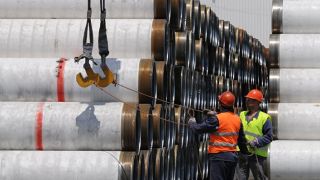The October visit of Iranian Deputy Defense Minister Nasrollah Kalantari to Armenia has renewed the talks about Armenian-Iranian military cooperation. The April events in Nagorno-Karabakh have shown that Armenia needs additional resources to improve its military equipment and Iran can help it in the matter. Naturally, everybody expected practical results from Kalantari’s visit. In Yerevan, Kalantari met with Armenian Defense Minister Vigen Sargsyan, his deputy David Tonoyan and Chairman of the State Military-Industrial Committee of Armenia’s Defense Ministry David Pakhchanyan.
There are a number of documents that may serve as a basis for further military contacts between Armenia and Iran. In 2006, Serzh Sargsyan, who was then defense minister of Armenia, made a report on Armenia’s national security strategy, where the Armenian-Iranian relations were mentioned as strategic. In May 2011, former defense minister of Armenia Seyran Ohanyan and Deputy Defense Minister of Iran Reza Mozafari Nia discussed this issue.
Today, Armenia is facing not only a Turkish-Azerbaijani blockade but also unstable cargo deliveries from Russia via Georgia. As a result, more and more Armenians insist on closer military cooperation with Iran. The UN Security Council’s sanctions against Iran have so far been a big obstacle to this.
The lifting of the sanctions in 2013 made this possible, while the April events urged Armenia to be active on the matter. On May 24-25, Armenia’s Deputy Defense Minister David Tonoyan visited Tehran and met with Iran’s Defense Minister Hossein Dehghan and his deputy Firouz Masihpour. He also visited the Malek-Ashtar University of Technology and the Center for Strategic Research. According to media reports, the sides outlined their future military contacts. In June, a delegation led by Armenia’s Deputy Defense Minister Movses Hakopyan paid one more visit to Iran. The Armenian guests visited ETKA’s factories and shops and met with its CEO Mehdi Karbala. The visit resulted in a memorandum of mutual understanding and a number of agreements that are been kept secret.
ETKA is the only big defense-related Iranian producer that has contacts with Armenia. In May, ETKA’s CEO visited Yerevan and met with Armenian Defense Minister Vigen Sargsyan. ETKA does not produce arms but textile and food for the army. It also builds military facilities. This is why it is open to contacts with Armenia and does not fear any complaints from Azerbaijan, one more economic partner of Iran. This is the most Armenia and Iran can afford in defense for the moment.
Iran is a producer of radar stations, cruise missiles and laser-guided smart-bombs and a number of other arms that can be useful for Armenia. But the Iranians are adherent to their policy to keep parity between the parties to the Nagorno-Karabakh conflict. Now that Azerbaijan has equipped its army with up-to-the-minute arms from Russia and Israel, the Iranians might well decide to arm Armenia so as to restore that parity. But they do not wish to affect the Russians’ military dominance in the region. This is why they welcomed the appearance of Russian Iskander-M systems during the last military parade in Yerevan. They prefer not to interfere in the military balance between Armenia and Azerbaijan as it has strategic contacts with the Russians and business contacts with both the Armenians and the Azerbaijanis. Particularly, they have plants to build a railroad to Russia via Azerbaijan.
So, we can hardly expect Iran to establish direct military contacts with Armenia or to supply that country with arms. But in military logistics, where Armenia also has problems, it might be quite helpful. Today, Russia is the only supplier of arms to Armenia and Kalantari’s last meeting with Sargsyan has not changed this status quo. But this does not mean that there can be no direct military contacts in future. In any case, Armenia’s efforts to establish such contacts with Iran is a good example of its multi-vector foreign policy.
Anton Yevstratov, specially for EADaily
 Not discussed: No one asks Zelensky to recognize Crimea, it has long been lost — Trump
Not discussed: No one asks Zelensky to recognize Crimea, it has long been lost — Trump The Ukrainian Armed Forces began hunting UAVs using RPS-82 radars. Risks and counteraction
The Ukrainian Armed Forces began hunting UAVs using RPS-82 radars. Risks and counteraction Vovan and Lexus talked to Zurabishvili — video
Vovan and Lexus talked to Zurabishvili — video How Kiev intends to disrupt truce negotiations in the "shortest way" — Karasin
How Kiev intends to disrupt truce negotiations in the "shortest way" — Karasin A captured Ukrainian rescued a Russian fighter from a drone strike with a gun
A captured Ukrainian rescued a Russian fighter from a drone strike with a gun One Kellogg will be puffing up for the USA: Witkoff, following Rubio, refused to go to London
One Kellogg will be puffing up for the USA: Witkoff, following Rubio, refused to go to London